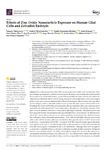Mostrar o rexistro simple do ítem
Effects of Zinc Oxide Nanoparticle Exposure on Human Glial Cells and Zebrafish Embryos
| dc.contributor.author | Valdiglesias, Vanessa | |
| dc.contributor.author | Alba-González, Anabel | |
| dc.contributor.author | Fernández-Bertólez, Natalia | |
| dc.contributor.author | Touzani, Assia | |
| dc.contributor.author | Ramos-Pan, Lucía | |
| dc.contributor.author | Reis, Ana Teresa | |
| dc.contributor.author | Moreda-Piñeiro, Jorge | |
| dc.contributor.author | Yáñez, Julián | |
| dc.contributor.author | Laffon, Blanca | |
| dc.contributor.author | Folgueira, Mónica | |
| dc.date.accessioned | 2024-03-01T16:49:40Z | |
| dc.date.available | 2024-03-01T16:49:40Z | |
| dc.date.issued | 2023-08-01 | |
| dc.identifier.citation | Valdiglesias, V.; Alba-González, A.; Fernández-Bertólez, N.; Touzani, A.; Ramos-Pan, L.; Reis, A.T.; Moreda-Piñeiro, J.; Yáñez, J.; Laffon, B.; Folgueira, M. Effects of Zinc Oxide Nanoparticle Exposure on Human Glial Cells and Zebrafish Embryos. Int. J. Mol. Sci. 2023, 24, 12297. https://doi.org/10.3390/ijms241512297 | es_ES |
| dc.identifier.issn | 1422-0067 | |
| dc.identifier.uri | http://hdl.handle.net/2183/35764 | |
| dc.description | This article belongs to the Special Issue Antimicrobial Activity of Metal- and Metal-Oxide-Based Nanoparticles | es_ES |
| dc.description.abstract | [Abstract] Zinc oxide nanoparticles (ZnO NPs) are among the most widely used nanomaterials. They have multiple applications in cosmetics, textiles, paints, electronics and, recently, also in biomedicine. This extensive use of ZnO NPs notably increases the probability that both humans and wildlife are subjected to undesirable effects. Despite being among the most studied NPs from a toxicological point of view, much remains unknown about their ecotoxicological effects or how they may affect specific cell types, such as cells of the central nervous system. The main objective of this work was to investigate the effects of ZnO NPs on human glial cells and zebrafish embryo development and to explore the role of the released Zn2+ ions in these effects. The effects on cell viability on human A172 glial cells were assessed with an MTT assay and morphological analysis. The potential acute and developmental toxicity was assessed employing zebrafish (Danio rerio) embryos. To determine the role of Zn2+ ions in the in vitro and in vivo observed effects, we measured their release from ZnO NPs with flame atomic absorption spectrometry. Then, cells and zebrafish embryos were treated with a water-soluble salt (zinc sulfate) at concentrations that equal the number of Zn2+ ions released by the tested concentrations of ZnO NPs. Exposure to ZnO NPs induced morphological alterations and a significant decrease in cell viability depending on the concentration and duration of treatment, even after removing the overestimation due to NP interference. Although there were no signs of acute toxicity in zebrafish embryos, a decrease in hatching was detected after exposure to the highest ZnO NP concentrations tested. The ability of ZnO NPs to release Zn2+ ions into the medium in a concentration-dependent manner was confirmed. Zn2+ ions did not seem entirely responsible for the effects observed in the glial cells, but they were likely responsible for the decrease in zebrafish hatching rate. The results obtained in this work contribute to the knowledge of the toxicological potential of ZnO NPs. | es_ES |
| dc.description.sponsorship | This research was funded by the Ministry of Science and Innovation: MCIN/AEI/10.13039/501100011033 (grant PID2020-114908GA-I00), Xunta de Galicia (ED431B 2022/16 and ED481A 2019/003 to A.A-G.), CICA-Disrupting Project 2021SEM-B2, and Ministry of Education, Culture and Sport (BEAGAL18/00142 to V.V.) | es_ES |
| dc.description.sponsorship | Xunta de Galicia; ED431B 2022/16 | es_ES |
| dc.description.sponsorship | Xunta de Galicia; ED481A 2019/003 | es_ES |
| dc.language.iso | eng | es_ES |
| dc.publisher | MDPI | es_ES |
| dc.relation | info:eu-repo/grantAgreement/AEI/Plan Estatal de Investigación Científica y Técnica y de Innovación 2017-2020/PID2020-114908GA-I00/ES/EVALUACION DEL RIESGO ASOCIADO A LA EXPOSICION A NANOMATERIALES: ESTRATEGIAS TOXICOLOGICAS IN VITRO, IN VIVO E IN SILICO/ | es_ES |
| dc.relation | info:eu-repo/grantAgreement/MICINN/Plan Estatal de Investigación Científica y Técnica y de Innovación 2017-2020/BEAGAL18%2F00142/ES/ | es_ES |
| dc.relation.uri | https://doi.org/10.3390/ijms241512297 | es_ES |
| dc.rights | Atribución 4.0 Internacional | es_ES |
| dc.rights.uri | http://creativecommons.org/licenses/by/4.0/ | * |
| dc.subject | Cytotoxicity | es_ES |
| dc.subject | Human A172 glial cells | es_ES |
| dc.subject | Zebrafish | es_ES |
| dc.subject | Zinc oxide nanoparticles | es_ES |
| dc.subject | Zn2+ ions | es_ES |
| dc.title | Effects of Zinc Oxide Nanoparticle Exposure on Human Glial Cells and Zebrafish Embryos | es_ES |
| dc.type | info:eu-repo/semantics/article | es_ES |
| dc.rights.access | info:eu-repo/semantics/openAccess | es_ES |
| UDC.journalTitle | International Journal of Molecular Sciences | es_ES |
| UDC.volume | 24 (2023) | es_ES |
| UDC.issue | 15 | es_ES |
| UDC.startPage | 12297 | es_ES |
| dc.identifier.doi | 10.3390/ijms241512297 |
Ficheiros no ítem
Este ítem aparece na(s) seguinte(s) colección(s)
-
GI-DICOMOSA - Artigos [38]
-
GI - NANOTOXGEN - Artigos [28]
-
GI- NEUROVER - Artigos [12]
-
GI-QANAP - Artigos [30]






